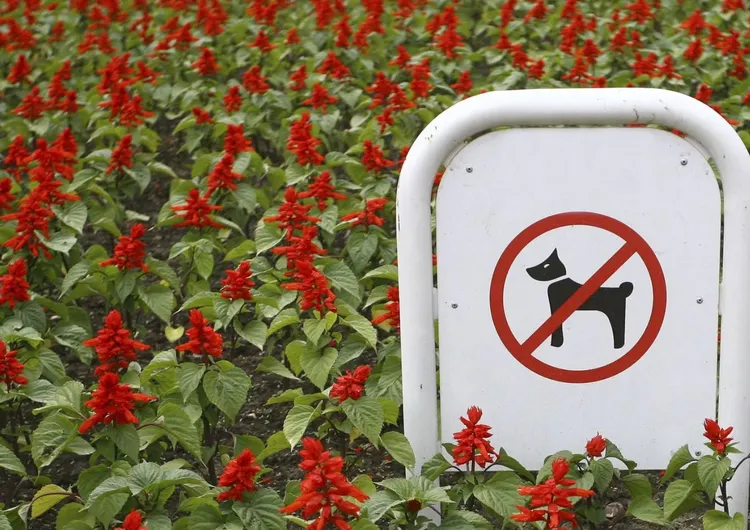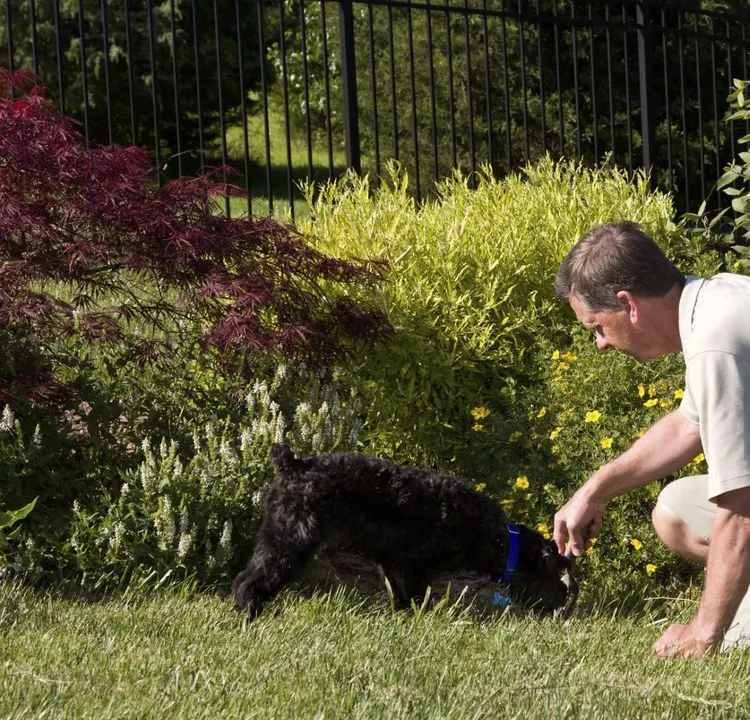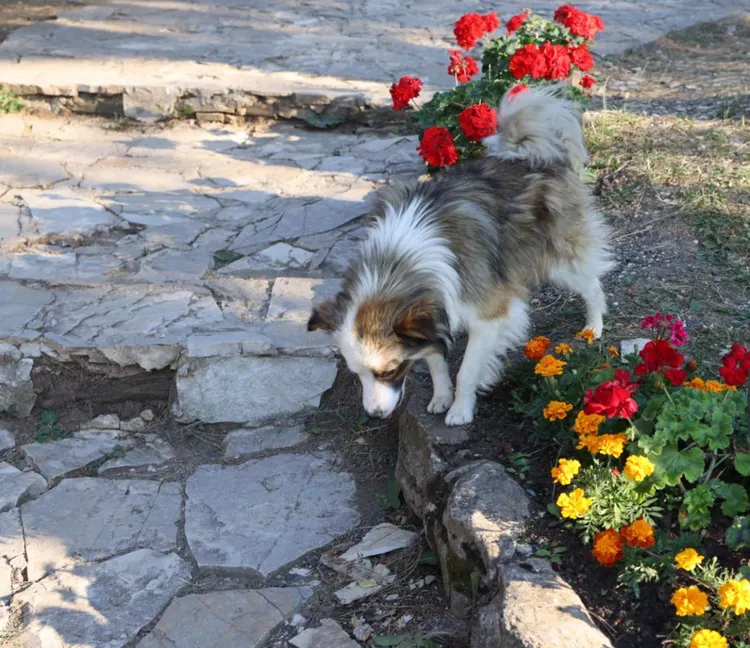You’ve spent hours planting, watering, and tending to your flower beds, only to discover that a dog—either your own or a neighbor’s—has trampled through, digging up flowers and turning your hard work into a mess. While it may seem like a frustrating challenge, there are plenty of eco-friendly, humane ways to keep dogs out of your flower beds without harming them or the environment. By combining natural deterrents, preventive actions, and training techniques, you can protect your garden while keeping the dogs happy and safe.
1. Why Do Dogs Love Flower Beds?
Before jumping into solutions, it’s important to understand why dogs are drawn to flower beds in the first place. By recognizing the root causes of their behavior, you can better plan strategies to prevent it.
Soft Soil and Digging Instincts
Dogs love to dig, and soft garden soil is a tempting invitation. The texture of the soil makes it easy for them to bury things or simply dig for fun. This behavior is rooted in their ancestral instincts when wild dogs would dig to find food or create comfortable resting spots.
Scent Attraction
Some flowers, fertilizers, or mulch might have scents that intrigue dogs. Organic fertilizers made from bone meal, blood meal, or fish emulsion can be especially appealing to their keen sense of smell. Additionally, some flowers may produce odors that excite or attract dogs to investigate and potentially dig around.
Territory Exploration
Dogs naturally explore new areas by marking their territory. If a dog is frequently in your yard, they may see your flower bed as part of their space to mark, dig, or investigate. This behavior could be driven by a dog’s need to claim the area as its own.
2. Eco-Friendly Physical Barriers
One of the most effective ways to keep dogs out of flower beds is by using physical barriers. These methods don’t involve harsh chemicals or harmful practices and help create a separation between dogs and your plants.
Garden Fencing
A simple and effective solution is installing a low fence around your flower beds. Consider using eco-friendly materials like bamboo or reclaimed wood for a natural look. These barriers don’t need to be tall—just enough to signal to dogs that the area is off-limits. If the dog can’t easily access the area, they’ll likely lose interest.
Mulching with Pinecones or Pebbles
Dogs tend to avoid walking on uncomfortable surfaces. By adding a layer of pinecones, pebbles, or large stones to your flower beds, you create a surface that feels unpleasant to dogs underfoot, discouraging them from digging or exploring. These natural materials are not only eco-friendly but also blend into the garden aesthetic.
Raised Flower Beds
Raising your flower beds can be an excellent long-term solution for keeping dogs out. Raised beds are less accessible to dogs and can deter them from jumping in. Additionally, they provide better drainage for your plants and reduce the likelihood of soil compaction caused by curious paws.

3. Use Natural Repellents
Natural repellents are an environmentally friendly and humane way to keep dogs out of flower beds. These substances are safe for both pets and plants, and they offer a non-toxic alternative to chemical repellents.
Citrus Peels or Vinegar Spray
Dogs generally dislike the smell of citrus. By scattering citrus peels (from oranges, lemons, or limes) around your flower beds, you create a natural deterrent that won’t harm your plants. Similarly, mixing vinegar with water and spraying it around the perimeter of the flower bed can deter dogs from entering the area. Be cautious with vinegar on plants, as it can affect the soil’s pH if overused.
Herbal Barriers
Certain plants naturally repel dogs due to their strong scents. Rosemary, lavender, and marigolds are examples of dog-repelling plants that can be used to border your flower beds. Not only do these plants act as a barrier, but they also enhance the beauty and fragrance of your garden. Additionally, some herbs, like rue, are effective at deterring dogs but should be used cautiously as they can be toxic to pets if ingested.
Coffee Grounds and Spices
Used coffee grounds can be an effective dog deterrent. The smell is unpleasant to dogs, and when sprinkled around the flower beds, it acts as a repellent. Plus, coffee grounds are excellent for your soil as they add nutrients. You can also sprinkle cayenne pepper around your flower beds to deter dogs; however, be cautious, as spicy substances can cause irritation if the dog ingests them or if they get into their eyes.
4. Create a Designated Dog Area
If the issue is with your own dog trampling the flower beds, a great solution is to create a designated area where your dog can dig and play freely. By offering an alternative space, you can redirect their energy and prevent damage to your plants.
Provide a Digging Zone
Designate a specific area in your yard where your dog is allowed to dig. You can create a sandpit or a soft-soil area for them to enjoy. Encourage them to use this space by burying toys or treats in the ground. When they dig in the designated zone, reward them with praise or treats. Over time, this positive reinforcement will train them to dig only in the approved area.
Reward Good Behavior
Whenever your dog avoids the flower beds or plays in their designated area, reward them with treats and positive reinforcement. This will help reinforce the behavior you want and make it more likely that your dog will respect the boundaries you’ve set in the future.
5. Long-Term Solutions and Training
For long-term success in keeping dogs out of flower beds, a combination of supervision, training, and preventive measures will be most effective. Here are some strategies to ensure lasting results:

Supervise Playtime
When your dog is outside, especially near the garden, make sure to supervise their playtime. If they start heading toward the flower beds, gently redirect them to their designated area. Over time, they’ll learn to associate the flower beds with “off-limits” behavior.
Use Pheromone Sprays
If your dog digs due to anxiety or stress, consider using natural pheromone sprays to calm them. These sprays mimic the calming pheromones that mother dogs produce and can help reduce anxiety-driven digging behavior.
Friendly Neighbor Talk
If the issue involves a neighbor’s dog, a friendly conversation can go a long way. Politely explain the situation and suggest that they supervise their dog or use a leash when walking near your yard. In some cases, you might offer eco-friendly deterrent suggestions that won’t harm the dog but will protect your garden.
Conclusion
Protecting your flower beds from curious canines doesn’t require harsh measures or harmful chemicals. With a little creativity and the right combination of natural deterrents, physical barriers, and training techniques, you can keep your garden thriving and your pets happy. The key is to focus on eco-friendly solutions that protect both your flowers and the environment. Whether it’s using citrus peels, installing low fencing, or providing a designated digging zone, you can find a strategy that works for your unique situation.
With some persistence and patience, you’ll enjoy a beautiful, dog-free flower bed while ensuring that all animals, including your own, remain safe and unharmed.



